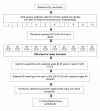HABITAT: A longitudinal multilevel study of physical activity change in mid-aged adults
- PMID: 19265552
- PMCID: PMC2664805
- DOI: 10.1186/1471-2458-9-76
HABITAT: A longitudinal multilevel study of physical activity change in mid-aged adults
Abstract
Background: Little is known about the patterns and influences of physical activity change in mid-aged adults. This study describes the design, sampling, data collection, and analytical plan of HABITAT, an innovative study of (i) physical activity change over five years (2007-2011) in adults aged 40-65 years at baseline, and (ii) the relative contribution of psychological variables, social support, neighborhood perceptions, area-level factors, and sociodemographic characteristics to physical activity change.
Methods/design: HABITAT is a longitudinal multi-level study. 1625 Census Collection Districts (CCDs) in Brisbane, Australia were ranked by their index of relative socioeconomic disadvantage score, categorized into deciles, and 20 CCDs from each decile were selected to provide 200 local areas for study inclusion. From each of the 200 CCDs, dwellings with individuals aged between 40-65 years (in 2007) were identified using electoral roll data, and approximately 85 people per CCD were selected to participate (N = 17,000). A comprehensive Geographic Information System (GIS) database has been compiled with area-level information on public transport networks, footpaths, topography, traffic volume, street lights, tree coverage, parks, public services, and recreational facilities Participants are mailed a questionnaire every two years (2007, 2009, 2011), with items assessing physical activity (general walking, moderate activity, vigorous activity, walking for transport, cycling for transport, recreational activities), sitting time, perceptions of neighborhood characteristics (traffic, pleasant surroundings, streets, footpaths, crime and safety, distance to recreational and business facilities), social support, social cohesion, activity-related cognitions (attitudes, efficacy, barriers, motivation), health, and sociodemographic characteristics. Analyses will use binary and multinomial logit regression models, as well as generalized linear latent growth models.
Discussion: HABITAT will provide unique information to improve our understanding of the determinants of physical activity, and to help identify "people" and "place" priority targets for public policy and health promotion aimed at increasing physical activity participation among mid-aged men and women.
Figures
Similar articles
-
Change in walking for transport: a longitudinal study of the influence of neighbourhood disadvantage and individual-level socioeconomic position in mid-aged adults.Int J Behav Nutr Phys Act. 2014 Dec 10;11:151. doi: 10.1186/s12966-014-0151-7. Int J Behav Nutr Phys Act. 2014. PMID: 25492854 Free PMC article.
-
Neighborhood disadvantage and physical activity: baseline results from the HABITAT multilevel longitudinal study.Ann Epidemiol. 2010 Mar;20(3):171-81. doi: 10.1016/j.annepidem.2009.11.004. Ann Epidemiol. 2010. PMID: 20159488
-
Neighborhood socioeconomic disadvantage and body mass index among residentially stable mid-older aged adults: Findings from the HABITAT multilevel longitudinal study.Prev Med. 2017 Dec;105:271-274. doi: 10.1016/j.ypmed.2017.09.017. Epub 2017 Sep 27. Prev Med. 2017. PMID: 28963008
-
Neighborhood Disadvantage and Physical Function: The Contributions of Neighborhood-Level Perceptions of Safety From Crime and Walking for Recreation.J Phys Act Health. 2018 Aug 1;15(8):553-563. doi: 10.1123/jpah.2017-0423. Epub 2018 Apr 20. J Phys Act Health. 2018. PMID: 29676658
-
A Longitudinal Study Examining Changes in Street Connectivity, Land Use, and Density of Dwellings and Walking for Transport in Brisbane, Australia.Environ Health Perspect. 2018 May 3;126(5):057003. doi: 10.1289/EHP2080. Environ Health Perspect. 2018. PMID: 29729661 Free PMC article.
Cited by
-
Direct inpatient burden caused by foot-related conditions: a multisite point-prevalence study.BMJ Open. 2016 Jun 20;6(6):e010811. doi: 10.1136/bmjopen-2015-010811. BMJ Open. 2016. PMID: 27324710 Free PMC article.
-
Effect of questionnaire length, personalisation and reminder type on response rate to a complex postal survey: randomised controlled trial.BMC Med Res Methodol. 2011 May 6;11:62. doi: 10.1186/1471-2288-11-62. BMC Med Res Methodol. 2011. PMID: 21548947 Free PMC article. Clinical Trial.
-
Socioeconomic inequalities in physical function decline: multilevel longitudinal results from the HABITAT study.BMC Public Health. 2025 Jul 3;25(1):2378. doi: 10.1186/s12889-025-23309-8. BMC Public Health. 2025. PMID: 40610967 Free PMC article.
-
Diabetes and physical activity: A prospective cohort study.PLoS One. 2022 Oct 26;17(10):e0276761. doi: 10.1371/journal.pone.0276761. eCollection 2022. PLoS One. 2022. PMID: 36288344 Free PMC article.
-
Longitudinal associations between bicycling and having dependent children, in middle-aged men and women.Prev Med Rep. 2021 Jul 8;23:101479. doi: 10.1016/j.pmedr.2021.101479. eCollection 2021 Sep. Prev Med Rep. 2021. PMID: 34345577 Free PMC article.
References
-
- Haskell WL, Lee I-M, Pate R, Powell K, Blair S, Franklin B, Macera C, Heath G, Thompson P, Bauman A. Physical Activity and Public Health: Updated Recommendation for Adults from the American College of Sports Medicine and the American Heart Association. Medicine and Science in Sports and Exercise. 2007;39:1423–1434. doi: 10.1249/mss.0b013e3180616b27. - DOI - PubMed
-
- Armstrong T, Bauman A, Davies J. Physical activity patterns of Australian adults. Results of the 1999 National Physical Activity Survey. Canberra: Australian Institute of Health and Welfare; 2000. http://www.aihw.gov.au/publications/cvd/papaa/papaa.pdf
-
- Stokols D. Translating social ecological theory into guidelines for community health promotion. American Journal of Health Promotion. 1996;10:282–298. - PubMed



